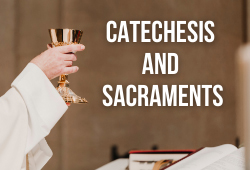Curriculum
Downloadable PDFsKindergarten
Grade 1
Grade 2
Grade 3
Grade 4
Grade 5
Required Biblical stories
Required prayers
USCCB Framework for Life Teen 2023
USCCB Framework for Life Teen 2024
Grades 6-8 will use the Edge program by Life Teen. During the three-year cycle, each program must complete two semesters on Morality, two semesters on Creed, and two semesters on Sacraments in any order preferred. Social Nights and Issue Nights, along with liturgical celebrations, community and service activities can be added to round out the needed number of contact hours, which remain at 40. View the USCCB Framework and Timeline as it correlates to Life Teen:
https://lifeteen.com/cym/framework-timeline/
Grade 9 will use the Life Teen Purpose program. The required sessions are available here: Purpose Lessons required. Additional sessions are available and encouraged. More information and the requirements for Confirmation are listed on the policy pages in section 630: https://www.eriercd.org/images/sections/religiouseducation/Confirmation.pdf
Grade 10 - following Confirmation, students will be invited to participate in Small Groups. Suggested activities and worksheets are available here: 6-12 Padlet. These Small Groups may continue throughout the remainder of the high school years.
Grade 11 – students are invited to participate in Spiritual Mentoring (coming in 2026). Until the new program is released, students are encouraged to continue Small Groups and become active members in the parish.
Grade 12 – students are invited to participate in Made for Mission (coming in 2027). Until the new program is released, students are encouraged to continue Small Groups and become active members in the parish.
Curriculum – Latin, meaning “course to be run.” In education this means not only those ideas and attitudes that are to be learned, but also the sequence in which they are to be studied. The curriculum shows how ideas build together over time to form a more and more complex understanding of the subject and ultimately of the world.
The faith formation curriculum for the diocese published in 1995 is organized by grade level.
Each grade level first identifies the overall goal.
The objectives are arranged in four areas identified as the key ingredients of catechesis by major Church documents. The learning objectives are intended to:
- increase their understanding of the faith (Message)
- form them into a community of believers, that is the Church (Community)
- increase their participation in the worship habits of the Church (Worship)
- increase their participation in and awareness of service as an important dimension of Catholic life (Service)
Within each grade, the curriculum provides a summary of the grade in a section referred to as “Content,” and also identifies the “Outcomes and Evaluation” that students are expected to master for that year. These outcomes are identified in three ways:
- The curriculum identifies what information the student should know
- What attitudes the student should display
- What behaviors the student should exhibit because they have participated in this course of study
The elementary curriculum of the diocese is indexed to the Catechism of the Catholic Church and you will see this indexing represented as Catechism-paragraph-numbers in a parenthesis following the learning objectives. This curriculum is written using the “student outcomes” model of curriculum development.

